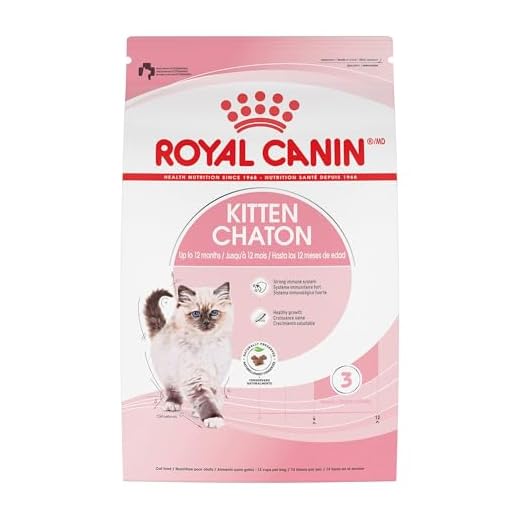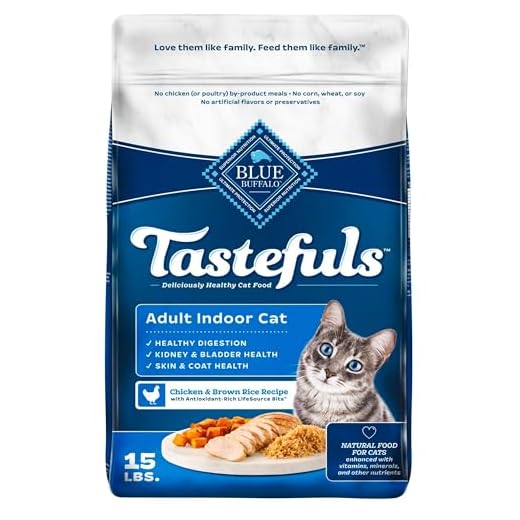



As an 8-year-old Scottish Fold, I’ve had my fair share of meals. The right moment to move from kitten nourishment to mature options typically occurs around the 12-month mark. This is when my body completes its growth phase, and my dietary needs shift significantly.
Pay attention to specific signs indicating readiness for this change. If I’m less playful or my energy levels drop, it’s a signal that my nutritional requirements have evolved. Additionally, consulting with my human veterinarian is a wise step to ensure a smooth transition tailored to my unique health profile.
Gradually introducing the new diet over a week helps avoid digestive upset. Mixing in the new offerings with the current staples allows my digestive system to adjust comfortably. A balanced formula designed for my age group supports my well-being, keeping my coat shiny and my energy levels high.
Monitoring my weight and overall health during this transition is crucial. Regular check-ups ensure that my new dietary choices meet my evolving needs. Staying informed means I can enjoy my meals while maintaining optimal health.
Optimal Timing for Transitioning to Mature Nutrition
Transition to a mature diet typically occurs between 10 to 12 months of age. This timeframe aligns with significant growth milestones, allowing for a balanced diet to support my overall health.
Observe weight gain patterns; a steady increase indicates readiness for a shift. A noticeable decrease in energy levels or increased food consumption may suggest the need for a diet change.
Consult a veterinarian for tailored advice. Factors such as breed, size, and individual health conditions can influence the ideal timing. Regular check-ups help ensure nutritional needs are met.
Gradual changes are crucial. Mixing current kibble with the new option over several days minimizes digestive upset. Monitor reactions closely during this period.
Ultimately, a well-timed adjustment supports long-term health and vitality. Enjoying a balanced diet tailored to my age helps maintain my playful spirit and overall well-being.
Understanding the Nutritional Needs of Kittens
At around four weeks of age, little furballs like me start shifting from mother’s milk to more solid nourishment. High protein content is crucial during this phase for muscle growth and energy. Look for options that boast at least 30% protein to fuel our playful antics.
- Calcium and phosphorus are essential for developing strong bones. The ideal ratio is about 1.2:1 for these minerals.
- Healthy fats, particularly omega-3 and omega-6 fatty acids, support brain development and a shiny coat.
- Vitamins such as A, D, and E play significant roles in overall health. These nutrients help with vision, immune function, and skin health.
Portion control matters. Frequent, small meals help maintain energy levels and ensure proper digestion. I enjoyed four to six meals a day while growing up, which kept me energized and satisfied.
Hydration is another key aspect. Fresh water must always be accessible. Dehydration can lead to serious health issues, so it’s essential to encourage drinking.
Transitioning to a different type of nourishment happens around one year old. It’s vital to monitor how your little one adjusts to new dietary options. Any signs of digestive upset could indicate the need for a slower introduction to new items.
Regular veterinary check-ups help ensure that nutritional needs are met and adjusted as necessary. Keeping an eye on weight and overall health can guide dietary choices as kittens grow into their unique selves.
Signs That Your Kitten is Ready for Adult Nutrition
As an 8-year-old Scottish Fold, I’ve seen many kittens grow up. Here are key indicators that it’s time for a change in their diet:
Age and Weight
Typically, once your furry friend reaches around 12 months, they often have the right weight and size for a more mature diet. Monitoring their growth can help determine if they are outgrowing their current meal plan.
Behavioral Changes
Increased activity levels and curiosity are common as kittens mature. If your little one is exploring more and playing vigorously, it might signal a need for different nutrient levels, which can be met with a more suitable option.
Additionally, signs of fullness, like leaving food in the bowl or showing less interest in meals, can indicate readiness for a different dietary approach. It’s essential to observe their eating habits closely, as appetite changes can reveal their nutritional needs.
Lastly, if you notice any dental changes, such as adult teeth coming in, that’s another clear sign that they may benefit from a more appropriate nutritional choice to support their health and development.
Age Guidelines for Transitioning to Adult Cat Food
For felines, the ideal age for moving to a mature diet is typically around 12 months. This timeline may vary based on individual growth rates and specific breed characteristics. Scottish Folds, like myself, often reach full maturity a bit later, so monitoring weight and body condition is key.
Between 6 to 12 months, observe any changes in activity levels and physical development. A noticeable increase in energy or reaching a stable weight can indicate readiness for a different nutritional approach. Transitioning too early can lead to potential deficiencies, while waiting too long may not support the evolving needs of your growing friend.
It’s also wise to consult with a veterinarian to tailor the dietary change to your unique needs. They can provide personalized advice based on your health and lifestyle, ensuring that the new meal plan aligns perfectly with your ongoing growth and vitality.
Staying attentive to these guidelines helps guarantee a smooth and beneficial transition as you mature. Focus on gradual adjustments, allowing your digestive system to adapt comfortably to the new offerings.
Choosing the Right Adult Cat Food for Your Pet
Prioritize high-quality protein sources like chicken, turkey, or fish. These ingredients support muscle health and maintain energy levels. Look for options with real meat as the first ingredient, avoiding fillers such as corn or soy.
Analyze the nutritional content. A balanced blend of proteins, fats, and carbohydrates is crucial. Check for adequate levels of taurine, an amino acid essential for heart health and vision. Aim for a minimum of 30% protein content for optimal growth and development.
Consider specific dietary needs. Some felines may require grain-free options due to sensitivities or allergies. If your furry friend is prone to weight gain, select a formula designed for weight management, often lower in calories and fat.
Examine additional health benefits. Certain brands offer formulas enriched with omega fatty acids for a shiny coat, probiotics for digestive health, and antioxidants to support the immune system. Choose products with these extras for overall well-being.
Pay attention to feeding guidelines. Transition gradually to prevent digestive upset. Start by mixing a small amount of the new product with the current meal, increasing the new proportion over several days until fully transitioned.
| Feature | Recommendation |
|---|---|
| Protein Source | High-quality meat (chicken, turkey, fish) |
| Protein Content | A minimum of 30% |
| Grain-Free | For those with allergies or sensitivities |
| Weight Management | Lower calorie and fat formulas for overweight pets |
| Health Benefits | Formulas with omega fatty acids, probiotics, and antioxidants |
Finally, consult your veterinarian for tailored advice based on your unique feline’s health and lifestyle. They can guide you in selecting the most suitable option for a healthy and happy life.
How to Gradually Introduce Adult Nourishment to Your Feline
Begin the transition with a mix of previous kitten nutrition and new mature options. A ratio of 75% kitten nourishment to 25% new blend works well for the first few days.
- Days 1-3: 75% kitten nourishment, 25% adult blend
- Days 4-6: 50% kitten nourishment, 50% adult blend
- Days 7-9: 25% kitten nourishment, 75% adult blend
- Day 10 onward: 100% adult blend
Monitor reactions closely. Look for any signs of digestive upset, such as vomiting or diarrhea. If problems occur, go back a step and proceed more slowly.
Make mealtime engaging. Place the new mixture in a separate bowl or use puzzle feeders to stimulate interest. This encourages exploration of the new taste and texture.
Consistency is key. Maintain a regular feeding schedule to help establish new habits. This routine supports your furry friend in adjusting to the change.
Hydration is equally crucial. Ensure fresh water is available at all times, especially when introducing new culinary options. This helps aid digestion and keeps your companion healthy.
Be patient. Some felines take longer to adapt to new nourishment than others. Respect their pace and offer encouragement throughout the transition.
Monitoring Your Pet’s Health During the Transition
Pay close attention to any changes in behavior or physical condition during this phase. I recommend keeping an eye on their appetite and energy levels. If you notice a sudden decrease in either, it may signal an issue that needs addressing.
Watch for gastrointestinal disturbances, such as diarrhea or vomiting, as these can indicate that the new nourishment isn’t settling well. A gradual introduction can mitigate these risks, but each individual is different, so stay alert.
Regularly check your friend’s weight. A healthy increase is expected, but any drastic fluctuations can be concerning. If your buddy seems to be gaining too much or losing weight, consult your vet.
Monitor hydration as well. Cats can be finicky about drinking water, especially with dry kibble. Ensure fresh water is always available. Dehydration can lead to serious health issues.
If your little one is prone to specific health issues, such as allergies or sensitivities, review the ingredient list carefully. A quality diet can help alleviate these concerns. If you’re unsure, consider discussing options with your veterinarian.
Lastly, if you’re looking for additional nutritional support, check out the best high calorie supplement for cats. It can provide an extra boost during this important transition.
Common Mistakes to Avoid When Transitioning Your Pet’s Diet
One major error is making abrupt changes to the menu. Gradual adjustments are vital to prevent digestive upset. Start by mixing small amounts of the new option with the current one, gradually increasing the new portion over several days.
Another pitfall is ignoring portion sizes. Adult meals often have different caloric densities compared to kitten formulas. Monitoring weight and adjusting servings accordingly helps maintain a healthy physique.
Choosing a product based solely on marketing claims can lead to disappointment. Always check the ingredient list and nutritional profile to ensure it meets your companion’s needs. Websites and reviews can provide insight, but personal observation is key.
Neglecting to Observe Changes
Failing to monitor behavior and health during the shift can be detrimental. Watch for signs of intolerance, such as vomiting or diarrhea. If these occur, consult a veterinarian for guidance.
Rushing the Process
Patience is crucial. A quick transition can lead to health issues. Take your time and be attentive to how your furry friend responds. Remember, it’s all about their well-being, not just getting them onto the new menu.
For those curious about cleaning products, check out this link: can i use purple power cleaner in my pressure washer.










